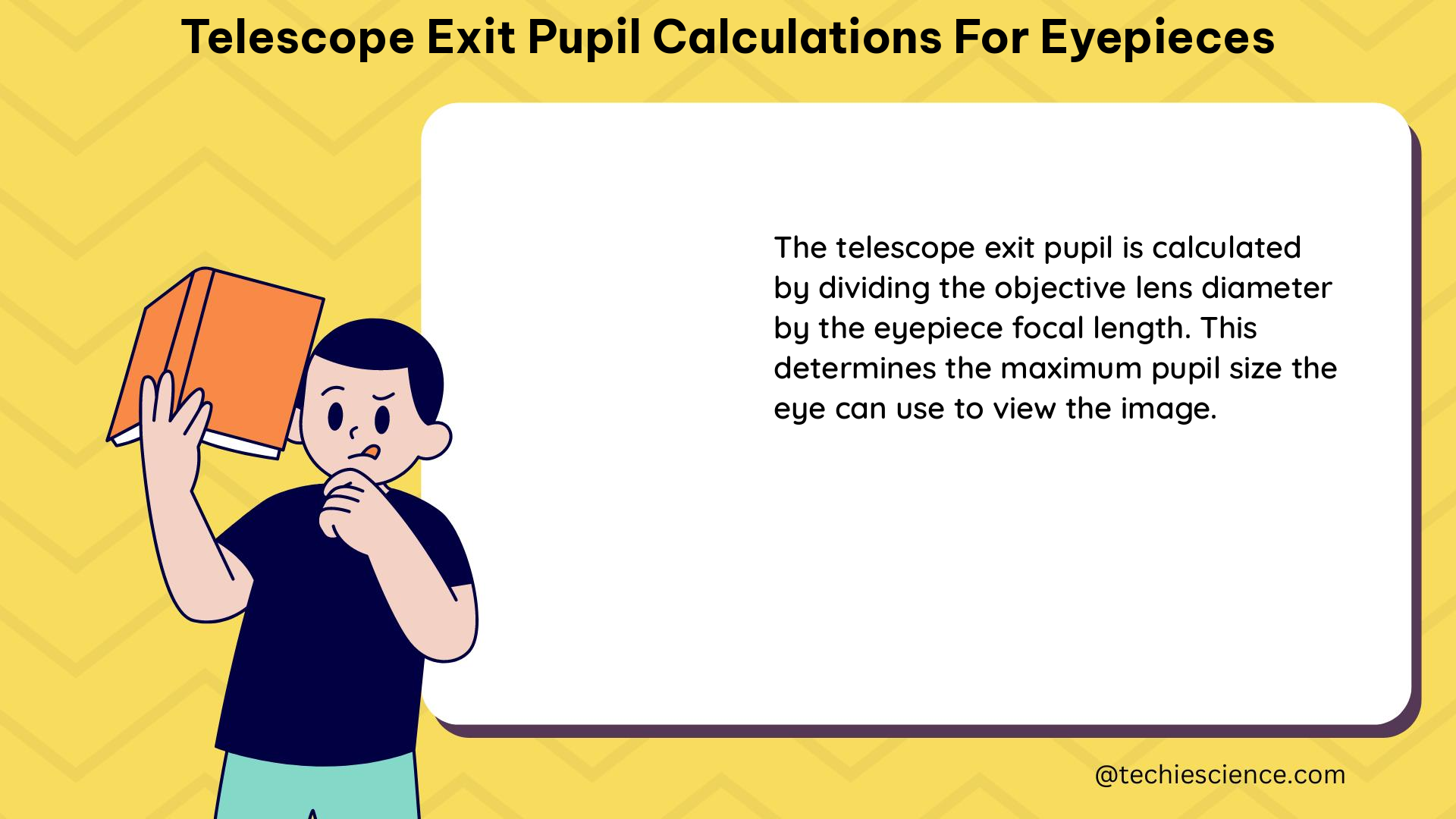The exit pupil of a telescope is a crucial factor to consider when choosing eyepieces, as it determines the amount of light that enters the observer’s eye. The exit pupil is calculated by dividing the focal length of the eyepiece by the focal ratio of the telescope. Understanding the relationship between the exit pupil, the telescope’s optical design, and the observer’s eye is essential for optimizing the viewing experience.
Understanding the Exit Pupil
The exit pupil is the image of the telescope’s objective lens or primary mirror as seen through the eyepiece. It represents the size of the beam of light that enters the observer’s eye. The formula for calculating the exit pupil is:
Exit Pupil = Eyepiece Focal Length / Telescope Focal Ratio
For example, if you have a telescope with a focal length of 1000mm and a focal ratio of f/5, and you are using a 25mm eyepiece, the exit pupil would be:
Exit Pupil = 25mm / (1000mm / 5) = 5mm
Factors Affecting the Exit Pupil

The exit pupil is influenced by several factors, including the telescope’s optical design, the eyepiece, and the observer’s eye.
Telescope Focal Ratio
The telescope’s focal ratio, or f-number, is the ratio of the telescope’s focal length to its aperture. A lower focal ratio (e.g., f/4) will result in a larger exit pupil, while a higher focal ratio (e.g., f/10) will result in a smaller exit pupil.
Eyepiece Focal Length
The focal length of the eyepiece also plays a role in determining the exit pupil. A shorter focal length eyepiece will produce a smaller exit pupil, while a longer focal length eyepiece will produce a larger exit pupil.
Observer’s Eye Pupil Size
The size of the observer’s eye pupil varies depending on the lighting conditions. In bright light, the pupil may be as small as 2mm, while in low light, it can expand to as much as 7mm. The ideal exit pupil should match the observer’s pupil size to maximize the amount of light entering the eye.
Optimal Exit Pupil for Observing
The optimal exit pupil for observing depends on the observing conditions and the observer’s preferences.
Bright Lighting Conditions
In bright lighting conditions, a smaller exit pupil (around 2-4mm) is preferred, as it provides a higher contrast and depth of field, which can be beneficial for observing details on the Moon, planets, or other high-contrast objects.
Low Lighting Conditions
In low lighting conditions, a larger exit pupil (around 5-7mm) is preferred, as it allows more light to enter the observer’s eye, resulting in a brighter image. This can be particularly useful for observing deep-sky objects, such as galaxies and nebulae.
Matching the Observer’s Pupil Size
As mentioned earlier, the ideal exit pupil should match the observer’s pupil size to maximize the amount of light entering the eye. This can be particularly important for observers who wear glasses, as the eye relief of the eyepiece can also affect the viewing experience.
Calculating the Exit Pupil for Different Telescope and Eyepiece Combinations
To help you determine the exit pupil for different telescope and eyepiece combinations, here are some examples:
| Telescope Focal Length | Telescope Focal Ratio | Eyepiece Focal Length | Exit Pupil |
|---|---|---|---|
| 1000mm | f/5 | 25mm | 5mm |
| 1500mm | f/8 | 32mm | 4mm |
| 2000mm | f/10 | 40mm | 4mm |
| 800mm | f/4 | 20mm | 4mm |
| 1200mm | f/6 | 28mm | 4.67mm |
Remember, these are just examples, and the actual exit pupil will depend on the specific telescope and eyepiece combination you are using.
Practical Considerations
When choosing eyepieces for your telescope, it’s important to consider not only the exit pupil but also other factors, such as the field of view, eye relief, and the overall viewing experience.
Field of View
The field of view (FOV) of an eyepiece is the angular size of the observed area. A wider FOV can provide a more immersive viewing experience, but it may come at the cost of a smaller exit pupil.
Eye Relief
Eye relief is the distance between the last lens of the eyepiece and the observer’s eye where the full field of view is visible. Eyepieces with longer eye relief are more comfortable for observers who wear glasses.
Viewing Experience
The overall viewing experience is a combination of factors, including the exit pupil, field of view, eye relief, and the observer’s personal preferences. Experimenting with different eyepiece combinations can help you find the optimal setup for your observing needs.
Conclusion
The exit pupil is a crucial factor to consider when choosing eyepieces for your telescope. By understanding the relationship between the exit pupil, the telescope’s optical design, and the observer’s eye, you can optimize the viewing experience and enjoy the best possible views of the night sky. Remember to consider other factors, such as the field of view and eye relief, to find the perfect eyepiece setup for your observing needs.
References:
- Telescope Optics – Exit Pupil
- Eyepiece Exit Pupil and Telescope Aperture
- Understanding Telescope Exit Pupil

The lambdageeks.com Core SME Team is a group of experienced subject matter experts from diverse scientific and technical fields including Physics, Chemistry, Technology,Electronics & Electrical Engineering, Automotive, Mechanical Engineering. Our team collaborates to create high-quality, well-researched articles on a wide range of science and technology topics for the lambdageeks.com website.
All Our Senior SME are having more than 7 Years of experience in the respective fields . They are either Working Industry Professionals or assocaited With different Universities. Refer Our Authors Page to get to know About our Core SMEs.